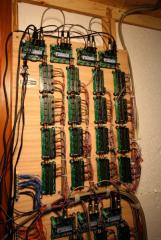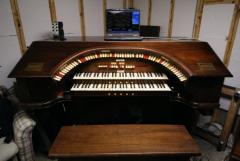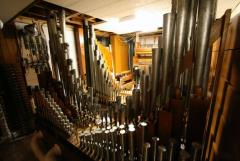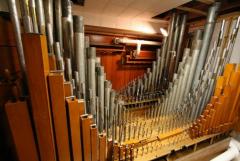
Trevor
Members-
Posts
63 -
Joined
-
Last visited
Contact Methods
-
AIM
oddrocketboy2
-
Website URL
http://www.acmeorgan.com/trevordodd/index.html
Profile Information
-
Gender
Male
-
Location
Battle Creek, MI
Trevor's Achievements

MIDIbox Newbie (1/4)
0
Reputation
-
Johnc, Sorry I've been away from the forum for a while! The Java app runs completely independently from jOrgan. I just use Eclipse to run it in the background. Just create a project in your favorite IDC using the two .java files. SAMs.java is the main file. Some parts of the code will still have to be modified a bit to fit your project. Trevor
-
newbie looking to drive small pipe organ with midibox
Trevor replied to maestro's topic in MIDIfication
maestro, I agree with everyone else that you really need to have jOrgan in the middle. In addition to the COREs, DINs, and DOUTs, you'll need something relatively "beefy" to drive the DE magnets. I managed to get away with ULN2803 transistor drivers because my Wurlitzer magnets were only 150-180 ohms. Trevor -
Thank you! This helps a lot!
-
TK (et al), In August, I am moving from Michigan to Oklahoma to go to school, and I need to sell my 7 rank Wurlitzer pipe organ before I go. Would it be ok to include the MIDIBox Cores (11), DINs (12), and DOUTs (27) in the sale? The MIDIBox boards are an integral part of the pipe organ and it would be nice to be able to provide a "plug and play" organ for the buyer. The organ is based on the MIDIO128 project, except for the swell shade project that I created with the help of MIDIBox/MidiTzer forum members. () and (http://site.virtualorgan.com/community/viewtopic.php?f=36&t=1950). Thank you for your consideration! -Trevor Dodd
-
johnh, I'm using the original Wurlitzer "on and off machine". I ended up using a 200ms delay; 333ms was a bit long. I'm going to leave the code as it is for now, since jOrgan has SAM control now. xpa, Percussions don't need anything like this. They just need the standard note on/off from the keyboard/piston because they're only active as long as the piston or key is active.
-
If anyone is interested, I threw together a little java app today that will handle SAMs from jOrgan. It's not MIOS-based of course, but it should do the trick until a better solution is found. It's set up to handle 64 SAMs on channel 10 (0-based); 0-63 are the ON magnets, and 64-127 are the off magnets. Here's an example: Stop #1 Activated: 155 0 127 Deactivated: 155 0 0 Stop #2 Activated 155 1 127 Deactivated 155 1 0 Stop #3 etc.... When Stop #1 is Activated, the app receives 155 0 127 (note 0 on, channel 10). The app then outputs 155 0 127, waits 333ms, then outputs 155 0 0. When Stop #1 is Deactivated, the app receives 155 0 0 (note 0 off, channel 10). The app then outputs 155 63 127, waits 333ms, then outputs 155 63 0. If anyone ends up building this from source, you'll have to change the two device name strings to the names of your input and output devices. Also you can change the delay time to fit your SAMs. I'm using a slightly longer time, because I'm using the original electro-pneumatic combination action. Eventually I'll make a GUI for this. SAMs.java import javax.sound.midi.Transmitter; import javax.sound.midi.Receiver; import javax.sound.midi.MidiUnavailableException; import javax.sound.midi.MidiDevice; import javax.sound.midi.MidiSystem; public class SAMs { private static boolean DEBUG = false; public static void main(String[] args) { /* The device name to listen to.*/ String strDeviceName = null; DEBUG = true; strDeviceName = "In From MIDI Yoke: 2"; if (DEBUG) { /*out("MidiInDump.main(): device name: " + strDeviceName);*/ } if (strDeviceName == null) { //out("device name not specified!"); System.exit(0); } MidiDevice.Info info = getMidiDeviceInfo(strDeviceName); if (info == null) { //out("no device info found for name " + strDeviceName); System.exit(1); } MidiDevice inputDevice = null; try { inputDevice = MidiSystem.getMidiDevice(info); inputDevice.open(); } catch (MidiUnavailableException e) { if (DEBUG) { } } if (inputDevice == null) { //out("wasn't able to retrieve MidiDevice"); System.exit(1); } Receiver r = new InReceiver(); try { Transmitter t = inputDevice.getTransmitter(); t.setReceiver(r); } catch (MidiUnavailableException e) { if (DEBUG) { out(e); } } /* Now, we're entering an endless loop. Otherwise, the program would exit and we won't have a chance to see any results. */ while (true) { try { Thread.sleep(1000); } catch (InterruptedException e) { if (DEBUG) { out(e); } } } } /* * This method tries to return a MidiDevice.Info whose name * matches the passed name. If no matching MidiDevice.Info is * found, null is returned. */ private static MidiDevice.Info getMidiDeviceInfo(String strDeviceName) { MidiDevice.Info[] aInfos = MidiSystem.getMidiDeviceInfo(); for (int i = 0; i < aInfos.length; i++) { if (aInfos[i].getName().equals(strDeviceName)) { return aInfos[i]; } } return null; } } InReceiver.java import javax.sound.midi.MidiDevice; import javax.sound.midi.MidiSystem; import javax.sound.midi.InvalidMidiDataException; import javax.sound.midi.MidiUnavailableException; import javax.sound.midi.MidiMessage; import javax.sound.midi.ShortMessage; import javax.sound.midi.Receiver; public class InReceiver implements Receiver { static Receiver rout; public InReceiver() { try { MidiDevice outputDevice = null; String outputDev = "Out To MIDI Yoke: 1"; MidiDevice.Info info = getMidiDeviceInfo(outputDev); outputDevice = MidiSystem.getMidiDevice(info); outputDevice.open(); rout = outputDevice.getReceiver(); } catch (MidiUnavailableException e) { System.out.println(e); } } public void close() { } private static MidiDevice.Info getMidiDeviceInfo(String strDeviceName) { MidiDevice.Info[] aInfos = MidiSystem.getMidiDeviceInfo(); for (int i = 0; i < aInfos.length; i++) { if (aInfos[i].getName().equals(strDeviceName)) { return aInfos[i]; } } return null; } public void send(MidiMessage message, long lTimeStamp) { int evnt0 = ((ShortMessage) message).getStatus(); int evnt1 = ((ShortMessage) message).getData1(); int evnt2 = ((ShortMessage) message).getData2(); if (message instanceof ShortMessage) { if(evnt0 == 155) new SetSAM(evnt1,evnt2,rout).start(); } } } class SetSAM extends Thread { int i; int pinnum; Receiver rec; SetSAM(int evnt1, int evnt2, Receiver r) { rec = r; if(evnt2>0) { pinnum=evnt1; } if(evnt2==0) { pinnum=evnt1+64; } } public void run() { ShortMessage on = new ShortMessage(); ShortMessage off = new ShortMessage(); try { //turn magnet on on.setMessage(155,pinnum,127); rec.send(on, -1); } catch (InvalidMidiDataException e1) { e1.printStackTrace(); } try { sleep(333); } catch (InterruptedException e) { e.printStackTrace(); } try { //turn magnet off off.setMessage(155,pinnum,0); rec.send(off, -1); } catch (InvalidMidiDataException e1) { e1.printStackTrace(); } } }
-
Here are some recordings of Wurlitzer opus 1614 installed in my basement. They are mostly of Wurlitzer Residence rolls converted to midi. http://www.acmeorgan.com/trevordodd/recordings.html It is controlled by jOrgan with MIDIbox input and output. There are a total of 12 COREs, 27 DOUTs, and 11 DINs. Almost everything uses the MIDIO128 project. The only exception are the swell shutters and tremulants which I wrote a special MIOS-based application for. The organ is still very much a work in progress, but it's getting there! I usually try to post new recordings at least once a week, so keep checking back if you like what you're hearing. http://www.acmeorgan.com/trevordodd/index.html (still under construction, but there is some info there) Enjoy!!! -Trevor
-
TK, how do I map the Device IDs? -Trevor
-
greetings! I ordered my latest 4 CORE kits with device IDs 9, A, B, and C. I was trying to make the .syx file from the .ini file and saw that I can only use PICs with IDs from 0-7. Is there a way around this other than changing the device ID? Thanks! -Trevor
-
Hey everyone! Would anyone happen to be interested in an application that uses CC volume data to drive swell shades? I wrote one for 12 stages, but it could be configured for any number of stages. I can also make a .hex file for anyone who doesn't have the ability to compile their own. Just send me the number of stages and which CC values each stage should be at. I hope this can help someone. I will post the code tomorrow since it's on the other computer. In the meantime, here's a video of my swell shutters being controlled by MIDIBox with my application.
-
Smash made the change so that both ULN and UDN chips could be used. I soldered jumpers in last night. It was a lot simpler than I thought it was going to be!
-
Yes, in R4 it looks like. I probably just have to solder jumpers, right?
-
CRAP! I just noticed that Smash changed the configuration of the DOUT where the driver chips go. How do I go about making the connections for the Vd and Vs to the ULN from the pins? ??? ??? ???
-
hey all, I got all of the boards built and programmed for the Main, percussions, and traps! On the Miditzer forum, Jim Henry and I have been discussing using CC messages from the swell output in Miditzer to drive shutters. I think it would be best to have the discussion moved here since it's pretty much Midibox specific. Here's a link to the Miditzer topic: http://site.virtualorgan.com/community/viewtopic.php?f=36&t=1950 Trevor




